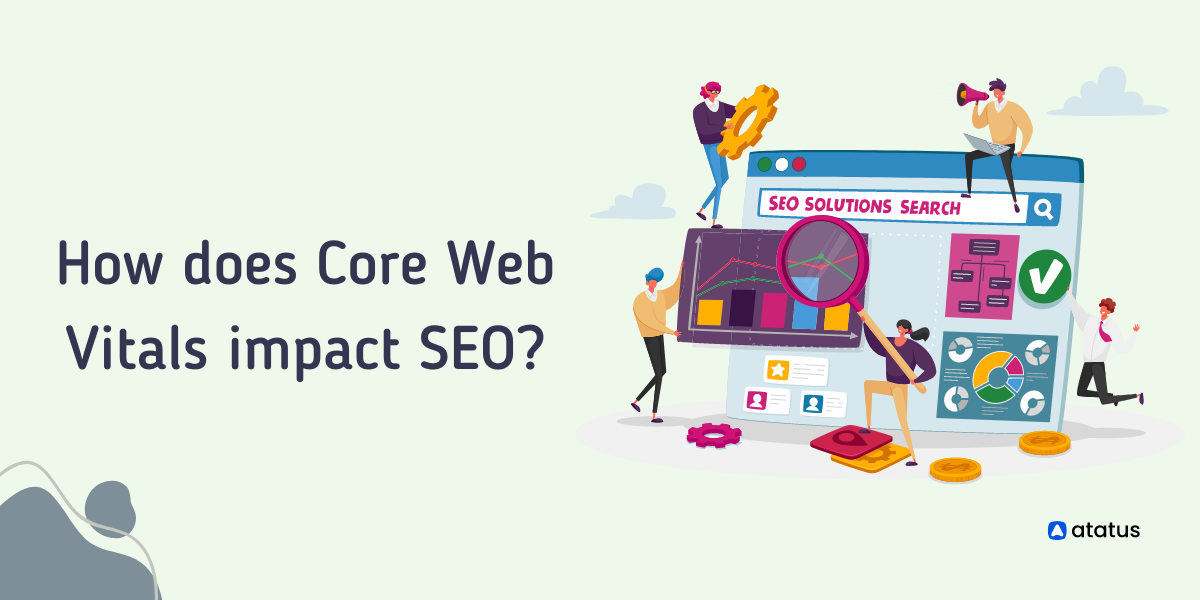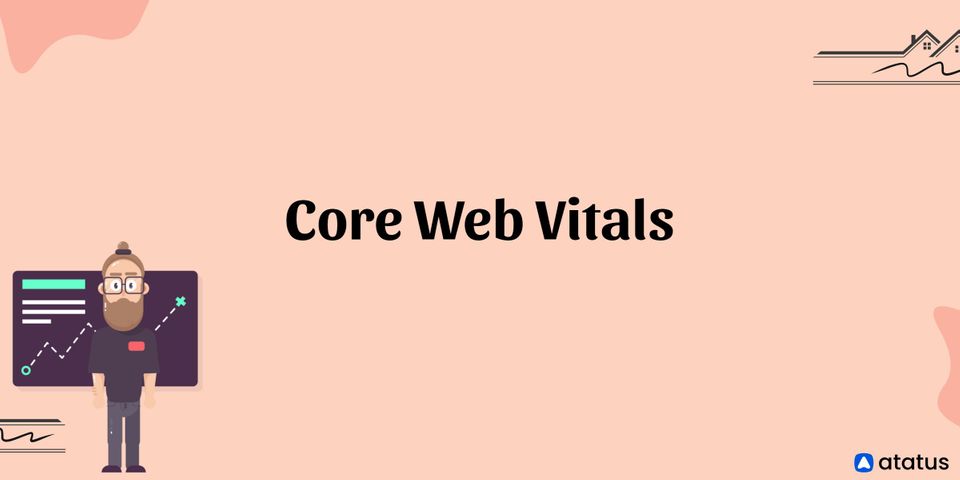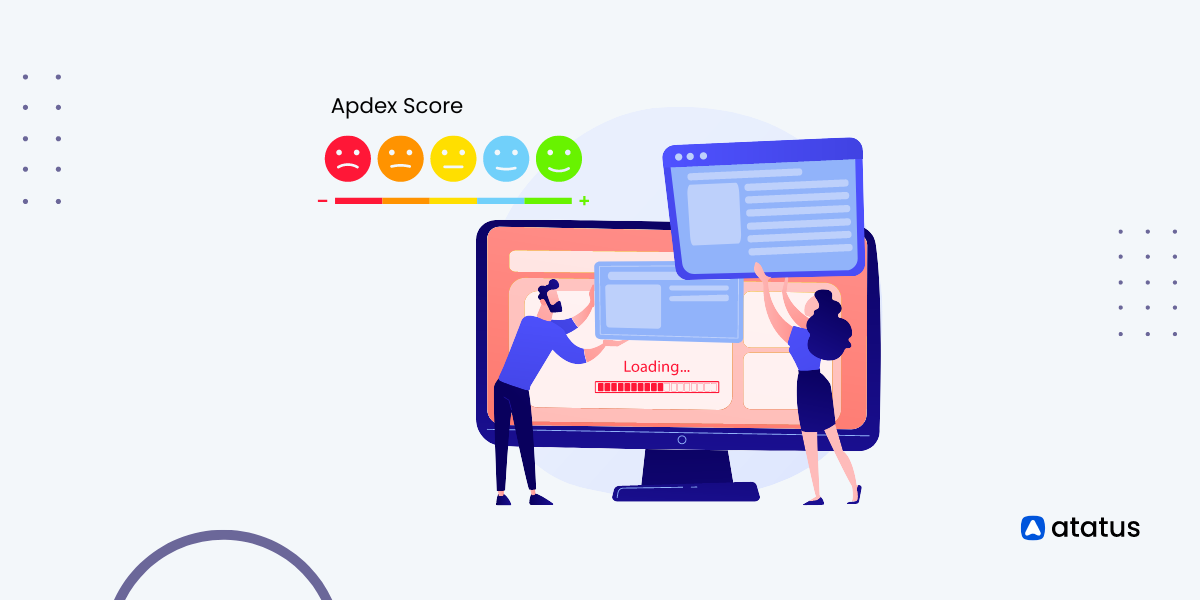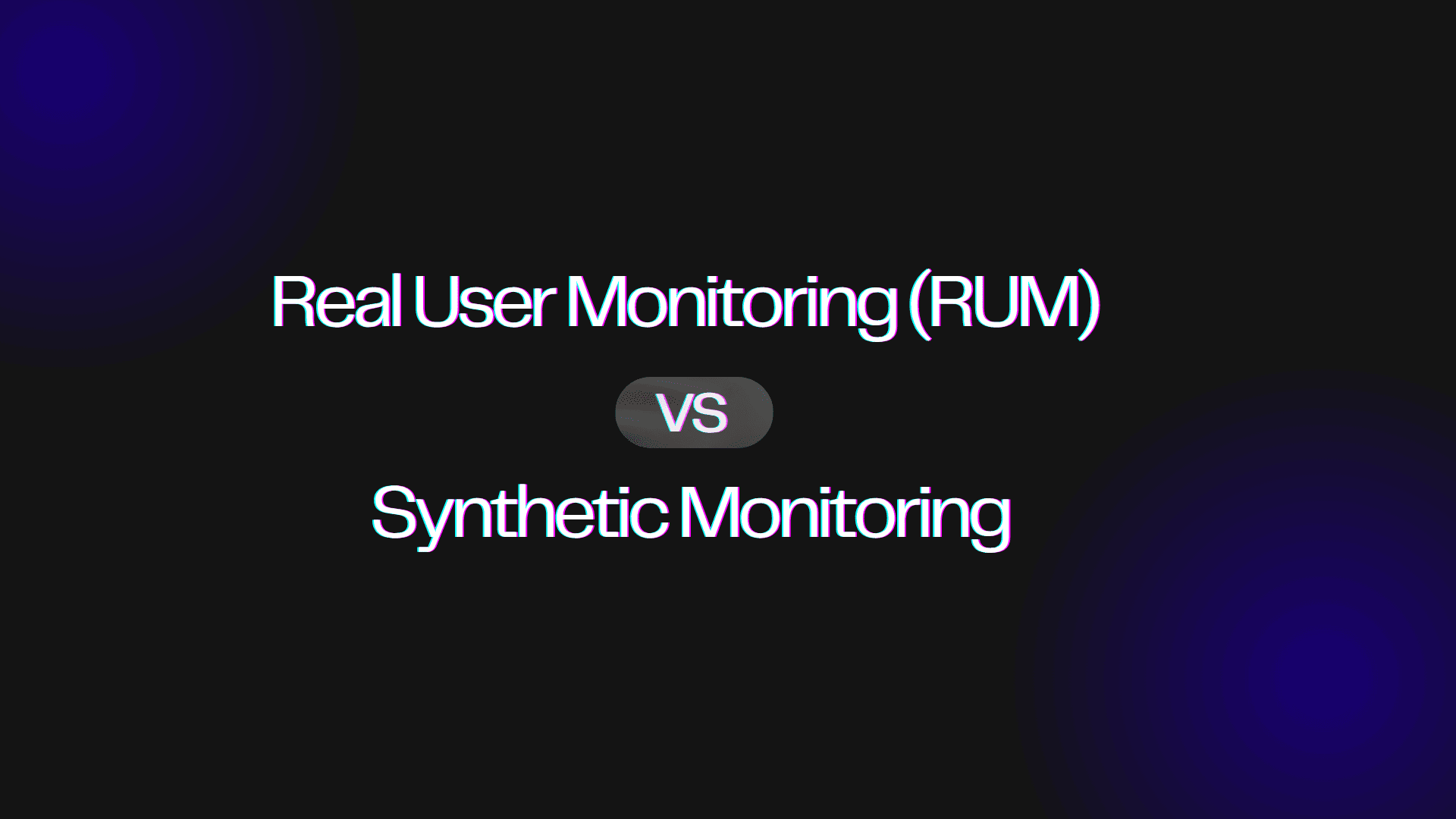How does Core Web Vitals impact SEO?
Google announced a new set of metrics known as “Core Web Vitals” which will be used as ranking factors in 2021.
The announcement is part of Google’s ongoing effort to make the web more user-friendly and to help site owners improve the experience for their visitors.
This is big news for site owners and SEO's who are always looking for ways to improve their site’s ranking on Google.
By understanding and improving the metrics used to measure user experience, they can improve their site’s ranking and visibility in search results.
- What are Core Web Vitals?
- Why core web vitals are important?
- Other challenging metrics in Core Web Vitals
- Top 7 technical SEO mistakes to be avoided
What are Core Web Vitals?
Google’s core web vitals are a set of standardized metrics that help developers and site owners measure the performance of their website and detect areas for improvement.
These are three main core web vital metrics that should be considered in the most thorough manner.
- Largest Contentful Paint (LCP)
- First Input Delay (FID)
- Cumulative Layout Shift (CLS)
These metrics will complement the existing PageSpeed Insights metrics, which measure the time to load a page. The Core Web Vitals metrics give insights into how a page is actually experienced by a user.
For example, LCP measures how long it takes for the largest element on a page to load. This is important because a slow loading page can become a frustration for a user. FID measures the delay between a user's first interaction with a page and the time when the browser responds to that interaction. This is important because a delay can make a page seem unresponsive. CLS measures how much the content of a page shifts around while the page is loading. This is important because it helps quantify how often user's experience unexpected layout shifts—a low CLS helps ensure the page is delightful.
Find out more about the core web vitals metrics on our blog - Core Web Vitals New Metrics for User Experience
What is the impact of Core Web Vitals on SEO?
Google Core Web Vitals are important because it helps search engines to understand the experience of the end-user on a website.
The search results will rank higher for a website that loads quickly and can be used easily than one that is slow and difficult to use.
Because of this, optimizing for the Core Web Vitals can make a big difference where the quality of information is largely the identical. It is important to remember that having valuable content on your site cannot be substituted.
Having faster pages can convert more visitors into customers and can rank your website #1 in Google search results.
Why Core Web Vitals are important?
Google announced page experience signals as a part of the Google ranking factor in 2020. More than a ranking factor, it is a tie-breaker metric that figures out which websites are worth spending time on.
Core web vitals not only influence user experience but also affect the performance of the web page. These are important because they help Google understand how well a site is performing and provide insight into the areas where you may need to improve the site.
It also helps in securing your website by protecting your site from online threats such as hacking and malfunctioning. Google measures the health of your website with the help of factors such as loading, interactivity, visual stability along with mobile-friendliness.
Therefore, putting core web vitals at the top of your priority list will improve your user experience and SEO.
Other challenging metrics in Core Web Vitals
It also offers much other information about your application that developers can use to improve the end-user experience.
1. First Contentful Paint Time (FCP)
FCP measures how long it takes for the browser to render the first DOM element on a user’s page. It includes images, canvas elements, or text.
It is the time it takes for the user to view some part of your web page. Those could be header bars or background images.
Although it may not be the first one loaded on the server, it usually appears first in the user's view, making it essential to the user's experience.
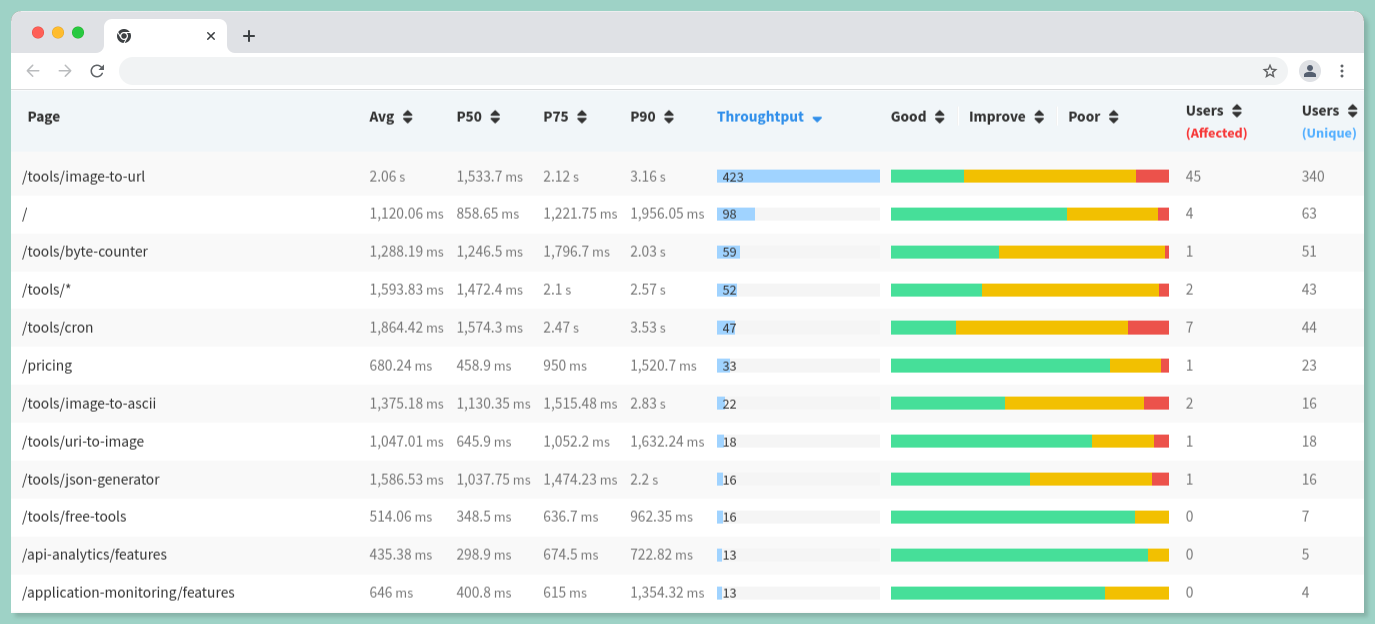
FCP does not account for anything contained within an iframe on your website. Changes in background color are not considered content painting. In other words, that is First Paint and not First Contentful Paint.
The range of FCP scores are:
- 0 - 2 seconds - This indicates the website is fast.
- 2 - 4 seconds - This is considered moderate.
- 4+ seconds - This is a sign that your website is slow.
Technical SEO experts regard an FCP of 1.8 seconds as an excellent response time.
2. Speed Index
When you load a page, the speed index indicates how quickly the content will be displayed visually.
This metric lets you know if your website has excessive JavaScript code and it is measured in milliseconds.
User experience and SEO are closely related. An optimized website should have a good Speed Index score since it improves the user experience for search engines.
The range of speed index scores are:
- 0 - 4.3 seconds (fast)
- 4.4 - 5.8 seconds (moderate)
- 5.8" seconds (slow)
3. Time to Interactive (TTI)
Web pages need not necessarily be fully loaded before using them. They can load while looking interactive and responsive.
The Time to Interactive (TTI) measures how long it takes for a page to load up to when it can respond to user input reliably after the main page resources have been loaded.
It helps you to identify the unnecessary JavaScript code in your application and is measured in seconds with a range of TTI scores:
- 0 - 3.8 seconds (fast)
- 3.9 - 7.3 seconds (moderate)
- 7.3+ seconds (slow)
4. Total Blocking Time
Total Blocking Time (TBT) measures the load responsiveness of a page. It is the total amount of time that the main web page gets blocked due to long-running tasks, preventing it from responding to user interactions while processing the load.
During a web page load, the browser's main thread performs several tasks, and TBT is affected by how many long tasks are being executed simultaneously. The task might include parsing HTML, DOM rendering, event processing, executing JavaScript and CSS, etc.
A long task is one which takes over 50 ms to run on the main thread. The main thread gets blocked during the interaction since the browser cannot intercept long-running tasks.
Too many blocking long-running tasks can affect the performance of the search queries by users that need a quick response. Having many blocking tasks will directly affect the SEO rankings of your web page.
It is measured in milliseconds and the score ranges from:
- 0 - 300 ms (fast)
- 300 - 600 ms (moderate)
- 600+ ms (slow)
Top 7 technical SEO mistakes to be avoided
In order to search for visibility and SEO success, you need to fix these common technical SEO issue.
- Mistake 1: Slow Page Speed
- Mistake 2: No HTTPs Security
- Mistake 3: Non-responsive web design
- Mistake 4: Bad sitemap and robots.txt files
- Mistake 5: Meta Robots NOINDEX Set
- Mistake 6: Broken redirected URLs
- Mistake 7: Content, title and meta description issues
Mistake 1: Slow page speed
Page load speed is a factor that directly affects rankings. Longer loading times result in a higher bounce rate, resulting in a lower Google ranking. Besides affecting bounce rates, conversions, and user experience, it can also affect bounce rates and conversions.
How to fix it?
You can easily fix a web page's speed by offloading the excessive JavaScript script and CSS, optimizing images, remove unused plugins, compress HTML, CSS and JS code.
You can also monitor how well your website is performing using a performance monitoring tool. Atatus, a real-time performance monitoring tool, monitors your entire web application and provide you with the comprehensive insights.
Mistake 2: No HTTPs security
You shouldn't risk getting left behind in the ever-changing world of SEO by not using HTTPS.
When you try to load your website in Google Chrome, it will display an warning error information "Your site is not secure". Users will navigate back to the SERP if they get to see this warning information.
How to fix it?
- Convert your site from HTTP to HTTPs by getting an SSL certificate from the Certificate authority.
- Once you have purchased and installed the certificate, your site will be secure.
Mistake 3: Non-responsive web design
CSS is used for responsive design. On a website, CSS governs colors, resolutions, screen sizes, and other style properties. Depending on what device you are using, responsive sites display differently, depending on how big your browser is.
In non-responsive sites, the screen size just gets smaller to fit the smaller screen, rather than automatically adapting at a code level. Reading content or interacting with the site is often difficult due to this pinching and zooming.
How to fix it?
In the header of a webpage, a line of HTML tells the device to set the viewport to its own width and not to scale.
<meta name="viewport" content="width=device-width">
Your responsive @media queries will begin to work again after inserting the above line into the header section of your HTML file.
Mistake 4: Bad sitemap and robot.txt files
Sitemaps are XML files that contains the list of all the web pages available in your website. It is used by search engines to crawl your website and index all the pages so that they can be included in search results. This helps you to improve the visibility of your website in the search engines.
Creating a sitemap file for your website is a good way to ensure that all the pages on your website are properly indexed by search engines. It is also a good way to keep track of all the pages on your website.
If you have a large website, you may want to consider using a sitemap generator to create your sitemap file.
Sample XML sitemap:
<?xml version="1.0" encoding="UTF-8"?>
<urlset xmlns="http://www.sitemaps.org/schemas/sitemap/0.9">
<url>
<loc>https://myshop.com/</loc>
<lastmod>2019-08-21T16:12:20+03:00</lastmod>
</url>
<url>
<loc>https://myshop.com.com/blog/</loc>
<lastmod>2019-07-31T07:56:12+03:00</lastmod>
</url>
</urlset>A robot.txt file is a text file that tells search engine crawlers which pages on your website to crawl and which pages to ignore. The file is placed in the root directory of your website. The contents of the file can be read by anyone who visits your website.
The purpose of the file is to manage how search engine bots crawl your website. For example, you might want to block certain pages from being crawled and indexed by search engines, or you might want to allow certain pages to be crawled but not indexed. The format of the file is very simple. Each line contains a single command.
A proper robot.txt file will look like this:
# robotstxt.org
User-agent: *
Disallow: /directory
Disallow: /wp-admin
Sitemap: https://www.myshop.com/sitemap.xml
Sitemap: https://www.myshop.com/blog/sitemap.xml
Sitemap: https://www.myshop.com/glossary/sitemap.xmlCreating a sitemap and robot.txt file is a good way to help improve your website's search engine optimization (SEO). It can also be used to exclude certain pages from being indexed, such as pages that contain sensitive information.
Mistake 5: Meta Robots NOINDEX Set
You can use the "meta robots" tag to tell crawlers not to index a page (make it unsearchable) or follow the links on a page. The "meta robots" tag is especially useful if you have a page on your website that you don't want search engines to index.
For example, you might have a "Thank you" page that users are redirected to after filling out a form or you might have a page with sensitive information that you don't want to be public. In these cases, you would use the "meta robots" tag to tell crawlers not to index.
NOINDEX can ruin your search visibility when configured incorrectly because it removes all pages with a specific configuration from Google's index. There is no doubt that this will have a negative impact on SEO.
Click on "View Page Source" on the web page to check if NOINDEX is enabled. In the source code, use the find command to find the following line.
<meta name="robots" content="NOINDEX, NOFOLLOW">Check with the development team whether the meta robots tag needs to be indexed. It is either necessary to delete and add the code line below or to completely remove the meta robots code line.
<meta name="robots" content=" INDEX, FOLLOW">Mistake 6: Broken redirected URLs
A redirect is a way to send both users and search engines to a different URL from the one they originally requested. There are several types of redirects, each with their own benefits and uses.
Meta refreshes and JavaScript redirects are not as effective as server-side redirects, and should generally be avoided. Server-side redirects are the most efficient and search engine friendly method of redirecting visitors.
Making your users to land on an error page which isn't a good end-user experience for the users tending to see a live web page. You can forward the traffic to the existing page with the help of the redirect option.
Too many redirects would result in a plunge in search engine rankings. According to Google, 301, 302, and 307 redirects do not harm SEO if they are used properly. As a matter of fact, redirects can facilitate the process of transferring domains and updating permalink structures.
Best Practices:
- Redirect to the most relevant and similar pages
- Avoid redirect chain
- Avoid soft 404s
- Update the internal links
- Avoid meta
refreshertag
Mistake 7: Content, title and meta description issues
One of the most important aspects of SEO is creating quality content that applies to your target audience. However, if your content is not properly optimized, it may not be appearing on search engine results pages (SERPs), or it may appear lower than desired.
Besides content, your page title and meta description are also important factors in SEO. If you are not using the right keywords or if your meta description is not interesting, you may miss out on valuable traffic.
One of the major issue is the duplicate content since it will be difficult for search engines like Google to rank your web page which has similar content.
If you're not paying attention to your meta descriptions, you're missing out on a valuable opportunity to improve your click-through rates. Meta descriptions are the brief descriptions that appear under your page title in the search engine results pages.
While they don't directly affect your search engine ranking, they do play an important role in helping potential visitors decide whether to click through to your site.
Unfortunately, many site owners either don't bother with meta descriptions at all, or don't take the time to write effective ones. As a result, they're missing out on a chance to boost their traffic and improve their business.
How to fix?
- Add meta descriptions for missing pages.
- Identify, evaluate and optimize meta descriptions errors.
- Check for duplicate content in your page and optimize them.
- To avoid losing keywords due to truncation by Google, ensure that your meta description and title tags contain your targeted keywords.
Conclusion
In conclusion, Google says that crawl rate, indexation rate, and load speed are important for SEO ranking, because slower sites may take longer to load. Slower sites may also take more time for Google to crawl, index, and rank pages. The faster a site loads, the more likely it is to be indexed and ranked higher.
Core Web Vitals is an advanced web monitoring designed to track the health of your website performance and track important SEO metrics. The all-in-one dashboard provides detailed performance insights. You can easily monitor all the essential metrics such as page load time, speed, SEO score, HTTP errors, and many more.
Web Vitals offers a way for companies to evaluate performance, identify issues, track progress, and make data-driven decisions. It also helps companies to develop and execute their digital marketing strategies.
Atatus Real User Monitoring
Atatus is a scalable end-user experience monitoring system that allows you to see which areas of your website are underperforming and affecting your users. Understand the causes of your front-end performance issues and how to improve the user experience.
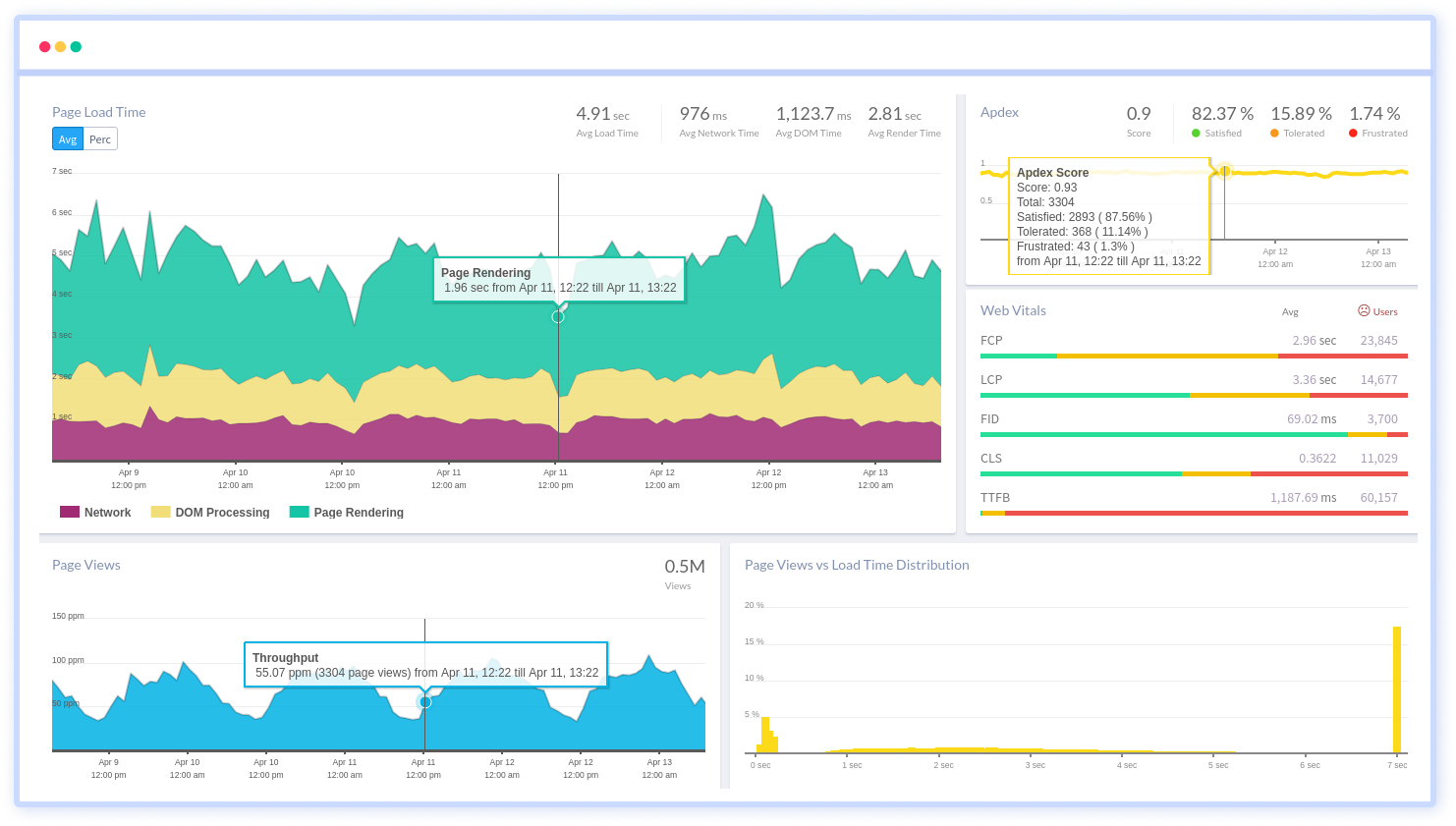
By understanding the complicated frontend performance issues that develop due to slow page loads, route modifications, delayed static assets, poor XMLHttpRequest, JS errors, and more, you can discover and fix poor end-user performance with Real User Monitoring (RUM).
You can get a detailed view of each page-load event to quickly detect and fix frontend performance issues affecting actual users. With filterable data by URL, connection type, device, country, and more, you examine a detailed complete resource waterfall view to see which assets are slowing down your pages.
#1 Solution for Logs, Traces & Metrics
APM
Kubernetes
Logs
Synthetics
RUM
Serverless
Security
More

